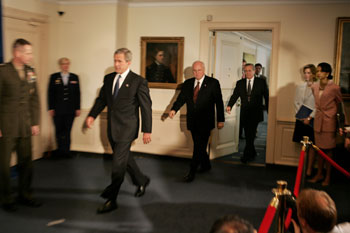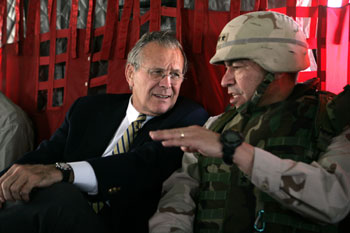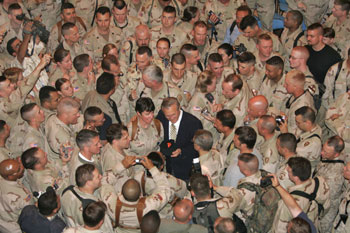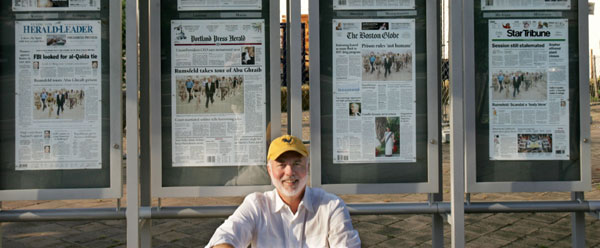After the first revelations surfaced about U.S. military personnel abusing Iraqi detainees at Abu Ghraib prison in Baghdad, I figured that once again I'd have to make that trip from my home in California back across the country to Washington, D.C.
Less than a week later I was taking pictures of the President, Vice President, and the Secretary of Defense as they marched out of Rumsfeld's office at the Pentagon after a meeting on that most unpleasant subject.
 |
Bush and Cheney at the Pentagon with Rumsfeld Photo by David Hume Kennerly/Getty Images |
The next day I received a tip that the Secretary of Defense was going to make a surprise overseas trip, and it wouldn't be to visit the NATO Allies in Brussels . . .
At one point it appeared that no civilian photographer was going to be manifested on the mission, but after I agreed to pool my photos it was decided that I could go along.
Under a shroud of secrecy, Secretary of Defense Donald Rumsfeld and the nation's top military leader, Chairman of the Joint Chiefs of Staff Richard Myers boarded a U.S. Air Force jet for the 14-hour non-stop trip to Kuwait.
We flew on the National Airborne Operations Center (NAOC), one of four National Military Command Centers, sometimes called the "Doomsday" plane, which is a militarized version of the 747. The NAOC is where the President would be taken in the event of a nuclear attack or some major emergency. The aircraft was chosen because of its ability to be refueled in midair, which happened twice each way.
In Kuwait, we boarded a C-130 cargo plane for the short flight to Baghdad. The aircraft made a tight corkscrewing turn as it descended into the Baghdad airport, pulling enough g's to make me feel like I weighed 500 pounds. The maneuver was necessary because of the real possibility of being shot at by surface-to-air missiles.
After landing in Baghdad, Rumsfeld was greeted by Lt. Gen. Ricardo Sanchez, the commander of Coalition forces in Iraq. They immediately boarded a Chinook helicopter for the short ride to Sanchez's headquarters in one of Saddam Hussein's old palaces for meetings with military leaders.
 |
Rumsfeld with LT GEN Ricardo Sanchez in the Chinook over Baghdad Photo by David Hume Kennerly/Getty Images |
A couple of hours later Rumsfeld's entourage took another helicopter for a hair-raising low-level flight to Abu Ghraib prison, ground zero of the prisoner mistreatment scandal.
Our transportation at Abu Ghraib was an olive-drab bulletproof Winnebago the first time I'd seen such a vehicle. I suppose it would be the perfect RV if you wanted to vacation in Grozny or Fallujah.
I was inside the reinforced RV with Rumsfeld and Myers as we drove past hundreds of imprisoned detainees, many of who expressed their unhappiness with rude gestures toward the Secretary's party. A few held up an Iraqi flag. The best pictures on the trip I never got to take. It was forbidden to photograph the detainees behind the barbed wire, a now rigidly enforced provision of an old rule.
 |
BAGHDAD, IRAQ.: Pool Photo: Abu Ghraib prison Photo by David Hume Kennerly/Getty Images |
The Secretary of Defense, accompanied by Maj. Gen. Geoffrey Smith who was the officer in charge of all the Iraqi prisons, grimly walked between the barb-wired compounds, taking measure of the situation. The desert boots he wore were a disparity to his business suit, but somehow fitting for a situation that was in every way a study in contrasts.
Rumsfeld had one more stop to make before leaving Baghdad. He addressed several hundred American troops at Al Faw Palace in a town hall setting where he answered questions from military personnel. At the end of his talk he was surrounded by the troops as they crowded around to him to shake his hand and to have their pictures taken with him.
 |
Pool Photo: Rumsfeld greets the troops Photo by David Hume Kennerly/Getty Images |
The trip was vintage Rumsfeld. At the hearings in Washington he had taken responsibility for what had happened at Abu Ghraib, but further, he decided to fly to Baghdad and the penitentiary itself to boost the morale of the troops still serving there. He felt strongly that it was his duty to show the soldiers that they had the backing of both the civilian and military leaders at the highest level. In the end I thought his journey proved to be as uplifting for his morale as it was for the men and women serving in Iraq.
From the time we departed Andrews Air Force Base at noon on Wednesday, May 12 until we returned at 6 a.m. Friday, May 14, the journey only lasted 42 hours-we were in the air for 31 of them.
My pictures of Rumsfeld's trip ended up on the front page of practically every newspaper in America, which was professionally satisfying to me. It's sad and ironic, however, that some of a journalist's greatest successes are born out of tragedies such as these.
 |
Photographer David Hume Kennerly in front of a display outside the Newseum showing his front page photos of Rumsfeld at Abu Ghraib |
David Hume Kennerly has been photographing history for four decades. For more of David Kennerly's photographs from Abu Grahib, go to kennerly.com.

